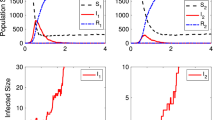Abstract
Highly infectious, immunizing pathogens can cause violent local outbreaks that are followed by the agent’s extinction as it runs out of susceptible hosts. For these pathogens, regional persistence can only be secured through spatial transmission and geographically asynchronous epidemics. In this paper we develop a hazard model for the waiting time between epidemics. We use the model, first, to discuss the predictability in timing of epidemics, and, second, to estimate the strength of spatial transmission. Based on the hazard model, we conclude that highly epidemic pathogens can at times be predictable in the sense that the waiting-time distribution between outbreaks is probabilistically bounded; The greater the spatial transmission the more periodic the outbreak dynamics. When we analyze the historical records of measles outbreaks in England and Wales between 1944 and 1965, we find the waiting-time between epidemics to depend inversely on community size. This is because large communities are much more tightly coupled to the regional metapopulation. The model further help identify the most important areas for spatial transmission. We conclude that the data on absence of these pathogens is the key to understanding spatial spread.
Similar content being viewed by others
References
Anderson RM and May RM (1991). Infectious diseases of humans: dynamics and control. Oxford University Press, Oxford
Bartlett MS (1956) Deterministic and stochastic models for recurrent epidemics. In: Neyman J (ed) Proceeding of the third Berkeley symposium on mathematical statistics and probability. University of California Press, Berkeley, pp 81–109
Bartlett MS (1957). Measles periodicity and community size. J R Stat Soc A 120: 48–70
Bartlett MS (1960) The critical community size for measles in the U.S. J R Stat Soc A 123:37–44
Bjørnstad O, Finkenstädt B and Grenfell BT (2002). Endemic and epidemic dynamics of measles. I. Estimating transmission rates and their scaling using a time series SIR model. Ecol Monogr 72: 185–202
Clark JS and Bjørnstad ON (2004). Population inference from messy data: errors, missing and hidden states and lagged responses. Ecology 85: 3140–3150
Cliff AD, Haggett P and Smallman-Raynor M (1993). Measles: an historical geography of a major human viral disease from global expansion to local retreat 1840–1990. Blackwell, Oxford
Erlander S, Stewart N (1990) The gravity model in transportation analysis – theory and extensions. Topics in Transportation. VSP, Utrecht
Eubank S, Guclu H, Kumar VSA, Marathe MV, Srinivasan A, Toroczkai Z and Wang N (2004). Modelling disease outbreaks in realistic urban social networks. Nature 429: 180–184
Fine PEM and Clarkson JA (1982). Measles in England and Wales. I. An analysis of factors underlying seasonal patterns. Int J Epidemiol 11: 5–15
Finkenstädt B and Grenfell B (2000). Time series modelling of childhood diseases: a dynamical systems approach. Appl Stat 49: 187–205
Finkenstädt B, Bjørnstad ON and Grenfell BT (2002). A stochastic model for extinction and recurrence of epidemics: estimation and inference for measles outbreaks. Biostatistics 3: 493–510
Glass K, Xia Y and Grenfell BT (2003). Interpreting time-series analyses for continuous-time biological models: measles as a case study. J Theor Biol 223: 19–25
Grenfell B and Bjørnstad O (2005). Sexually transmitted diseases: epidemic cycling and immunity. Nature 433: 366–367
Grenfell BT and Bolker BM (1998). Cities and villages: infection hierarchies in a measles metapopulation. Ecol Lett 1: 63–70
Grenfell B and Harwood J (1997). (Meta)population dynamics of infectious diseases. Trends Ecol Evol 12: 395–399
Grenfell BT, Bjørnstad ON and Kappey J (2001). Travelling waves and spatial hierarchies in measles epidemics. Nature 414: 716–723
Grenfell BT, Bjørnstad ON and Finkenstädt B (2002). Endemic and epidemic dynamics of measles. II. Scaling noise, determinism and predictability with the time series SIR model. Ecol Monogr 72: 185–202
Guimera R and Amaral LAN (2004). Modeling the world-wide airport network. Eur Phys J B 38: 381–385
Hanski I, Gaggiotti O (eds) (2004) Ecology, genetics, and evolution of metapopulations. Elsevier, Amsterdam
Hastie TJ, Tibshirani RJ (1990) Generalized additive models. Chapman and Hall, London
Keeling MJ and Rohani P (2002). Estimating spatial coupling in epidemiological systems: a mechanistic approach. Ecol Lett 5: 20–29
Keeling MJ, Bjørnstad ON, Grenfell BT (2004) Metapopulation dynamics of infectious diseases. In: Hanski I, Gaggiotti O (eds) Ecology, genetics, and evolution of metapopulations. Elsevier, Amsterdam, pp 415–445
Kendall DG (1949). Stochastic processes and population growth. J R Stat Soc B 11: 230–264
Liu WM, Iwasa Y and Levin SA (1986). Influence of nonlinear incidence rates upon the behaviour of SIRs epidemiological models. J Math Biol 23: 187–204
McCullagh P, Nelder JA (1989) Generalized linear models, vol 37 of Monographs on statistics and applied probability, 2nd edn. Chapman and Hall, London
Murray GD and Cliff AD (1975). A stochastic model for measles epidemics in a multi-region setting. Inst Br Geogr 2: 158–174
Rand DA and Wilson HB (1991). Chaotic stochasticity: a ubiquitous source of unpredictability in epidemics. Proc R Soc Lond B 246: 179–184
Rohani P, Keeling MJ and Grenfell BT (2002). The interplay between determinism and stochasticity in childhood diseases. Am Nat 159: 469–481
Smith DL, Lucey B, Waller LA, Childs JE and Real LA (2002). Predicting the spatial dynamics of rabies epidemics on heterogeneous landscapes. Proc Natl Acad Sci USA 99: 3668–3672
Xia Y, Bjørnstad ON and Grenfell BT (2004). Measles metapopulation dynamics: a gravity model for epidemiological coupling and dynamics. Am Nat 164: 267–281
Author information
Authors and Affiliations
Corresponding author
Rights and permissions
About this article
Cite this article
Bjørnstad, O.N., Grenfell, B.T. Hazards, spatial transmission and timing of outbreaks in epidemic metapopulations. Environ Ecol Stat 15, 265–277 (2008). https://doi.org/10.1007/s10651-007-0059-3
Received:
Revised:
Published:
Issue Date:
DOI: https://doi.org/10.1007/s10651-007-0059-3




